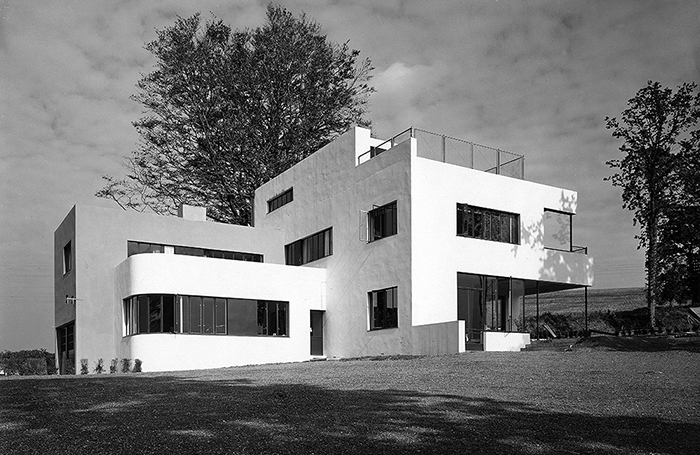Architecture Gallery, RIBA, 66 Portland Place, London, W1
1 October 2019 – 1 February 2020, free entry
This exhibition takes a fresh look at the development of British modernist architecture through the reciprocal influence of the Bauhaus movement.

Coinciding with the centenary of the Bauhaus school, the Royal Institute of British Architects (RIBA) presents an ambitious exhibition that revisits the impact of three notable Bauhaus émigrés: Walter Gropius, Marcel Breuer and László Moholy-Nagy. Centred on the brief period of 1934-37, when they came to live and work in Britain, the RIBA exhibition traces this fertile moment in British architectural history through the buildings completed during the decade. It considers the ideas they left behind and identifies the areas of post-war British architecture where its legacy has had the most enduring impact.
Exhibition highlights include:
- Drawings and plans produced by the short-lived partnership of Walter Gropius and Maxwell Fry, including the unbuilt Isokon 3 building
- Never before exhibited illustrations, sketches and personal photography from the archive of Leslie Martin and Sadie Speight
- Drawings of furniture and interior designs by Marcel Breuer and Wells Coates
- Photographs by ex-Bauhaus student Edith Tudor-Hart
- Archival films from the 1930s including work by László Moholy-Nagy
- Previous unseen personal correspondence and ephemera that tracks the personal lives of the key protagonists
- Exhibition design by Chile-based practice Pezo Von Ellrichshausen
The exhibition will be accompanied by a lively four-month programme of events taking a look at the wider cross-disciplinary impact of the Bauhaus, including talks, film screenings and creative learning workshops.
The Bauhaus presence in Britain was profound, championing not merely an architectural style but a philosophy, one based on an understanding of modern materials and technologies, and with a clear sense of social purpose. Drawing on the RIBA’s unique and world-class collections, Beyond Bauhaus examines the exchange between ex-Bauhaus tutors and young British architects, the many modernist influences of the era and the role of a group of pioneering women. Little known and rarely shown works by Elizabeth Denby, Sadie Speight, Margaret Blanco-White, Norah Aiton and Betty Scott demonstrate how important female architects engaged with the ideals of the modernist avant-garde.
The ways in which new ideas were exchanged and disseminated. will be presented through correspondence and personal ephemera that illustrate the depth of the personal relationships that flourished between British architects and their European counterparts. Other exhibits will broaden the narrative to show how the Bauhaus was among a number of influences that created a fast moving and highly experimental environment for young modernist architects to practice in.
Spanning 1933–66, this ambitious examination of the impact of émigré architects on Britain will conclude with a reflection on the work of, amongst others, Denys Lasdun, Eric Lyons, and Mary Crowley (later Medd), leading innovators in post-war British architecture whose formative years were spent as junior architects in the pre-war offices of Gropius, Fry, Goldfinger and Coates.
The exhibition will be accompanied by a display of László Moholy-Nagy’s photographic work and films produced during his time in Britain, working for the architectural press.
ENDS
Notes to editors:
- For further information contact Emily Stallard in the RIBA press office: Emily.Stallard@riba.org; 020 7307 3813.
- Press images can be downloaded here.
- Beyond Bauhaus – Modernism in Britain 1933–66 is co-curated by Pete Collard, Curator of Exhibitions at RIBA and Valeria Carullo, Curator of Photographs, RIBA.
- The exhibition is part of a RIBA season of wide-ranging events and workshops, designed for all ages and experience levels. Further information here.
- Beyond Bauhaus – Modernism in Britain 1933–66 forms part of the nationwide Insiders/ Outsiders arts festival taking place from March 2019 to March 2020 to celebrate refugees from Nazi Europe and their contribution to British culture. See here for further details.
- The Architecture Gallery at RIBA is open from 10am – 5pm Monday to Saturday and until 8pm every Tuesday. It is closed on Sundays. Free entrance. RIBA is at 66 Portland Place, London, W1B 1AD. Nearest tubes are Oxford Circus, Regent’s Park and Great Portland Street.
- The Architecture Gallery opened in February 2014 in the RIBA’s Grade II* listed Art Deco HQ. Through regular, free exhibitions that explore the past, present and future of our built environment the gallery programme will help visitors discover and explore architecture. The gallery offers the opportunity for the RIBA to display its world class collections contained in the British Architectural Library.
- The Royal Institute of British Architects (RIBA) is a global professional membership body that serves its members and society in order to deliver better buildings and places, stronger communities and a sustainable environment. www.architecture.com
- RIBA Collections Since its foundation in 1834, the RIBA has amassed one of the world’s largest and richest architectural collections, which now comprises over 4 million drawings, books, models and photographs. The RIBA curates this collection for the general public and specialist audiences and makes it available for research through galleries and reading rooms at its headquarters at 66 Portland Place, London, and at the Victoria & Albert Museum (with whom the RIBA has an architectural partnership)
- The RIBA is a registered charity and it relies on the generosity of individuals, companies, trusts and foundations to preserve its world-class collections, to maintain free public access to its exhibitions and develop a diverse and exciting public events programme. Follow @RIBA on Twitter for regular updates www.twitter.com/RIBA









